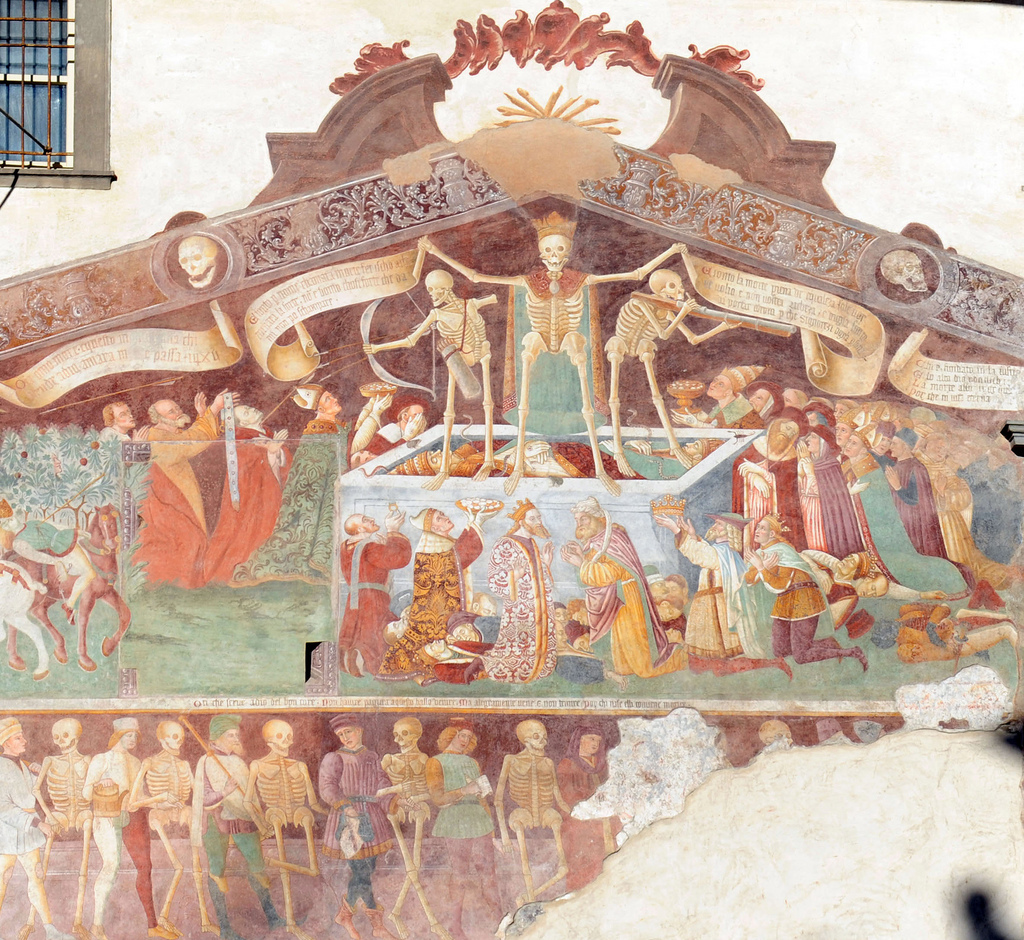Lombardy : Trionfo della Morte e Danza Macabra

The late fifteenth century fresco Trionfo della Morte e Danza Macabra can be found on the outer wall of the Oratorio dei Disciplini in Cluson, a small town in Bergamo in the Italian region of Lombardy. The artist of this piece is unknown although some speculate that it may have been the work of Giacomo Borlone de Buschis. Although little research has been done specifically on this fresco, it stands as an excellent example of both confraternity art as well as art made during the plague.
The danse macabre image in Clusone depicts both men and women being lead off one by one by skeletons. The facial expressions vary from fear to indifference and the clothing shows class variation. The placement of the danse macabre beneath the Triumph of Death might act as a further reminder of the inevitability of death. The facial expressions remind the viewer that one’s pious actions during life will affect the afterlife. Those looking content and facing forward have had a satisfying religious life, while those looking scared and leaning away must fear the afterlife due to lack of religious observance during life. The grim ironic humor of macabre images began to shift gears after the Plague and clergy and religious members started using this art form as a tool for religious propaganda.
In addition to the imagery of the danse macabre and the Triumph of Death, the legend of the three dead and three living is portrayed in the Clusone fresco. The triumph of death and the legend are fused together into one image. Ashby Kinch discussed the variations in the legend and concentrates on its role in Medieval literature. The legend goes that three aristocratic men are on a hunting trip and come across a forgotten burial ground. Suddenly three skeletal figures appear and remind the men of their inevitable death, they tell the men that soon they shall be as they appear. The writing on the Clusone fresco is similar to the legendary words of the death figures. In most cases, as Kinch states, the skeletal figures were once kings, but in other versions they were once ecclesiastical sinners. Clusone depicts the latter. The three skeletons stand over the corpses of religious figures, easily identified by their robes and headdresses. Their sin is represented by the vermin crawling over their bodies. Snakes, the symbol of ultimate sin dating back to the story of Adam and Even, slither over the dead clergy while toads and a scorpion line the tomb. Scorpions and toads were symbols of heresy during this time. This powerful image acts as a reminder that no matter ones social class, the sins committed will affect the afterlife. The skeletons, now acting as Kings of Death appear to hunt down those who have sinned.
Speculation about life after death became an obsession during the time of the Plague due to the massive amounts of death. Pope Benedict XII’s Benedictus Deus and Dante’s Inferno added to the anxiety created by the question of the afterlife. The Clusone fresco is just another example of Plague art directed towards a massive public audience to remind them to maintain a pious life because death is mysterious and can come without warning and by doing this one will enter the afterlife contently.
